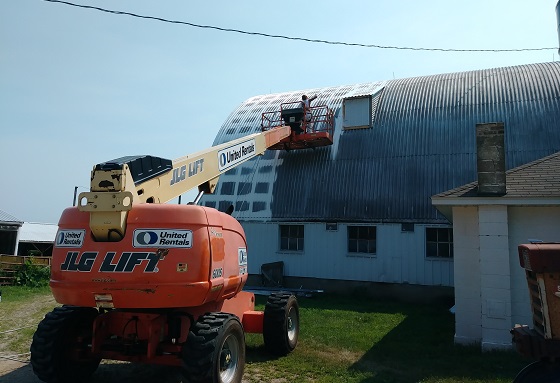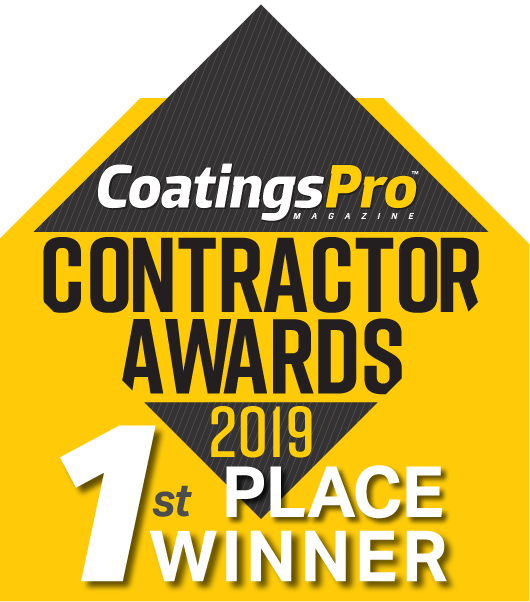R & G Miller & Sons, Inc. is an organic dairy farm in Columbus, Wisconsin, with a legacy that began in 1852. Today, eight family members, along with six full-time and a few part-time employees, all work together to produce milk that is sold under the Organic Valley brand.
One of the farm’s buildings, a barn from the 1940s, had been built with a corrugated R-panel steel roof and metal siding. Over the years, many of the roof’s mechanical fasteners had become loose or lost, and there were even bullet holes in some of the roof panels! The roof also had asphalt tar on it. For the age of the substrate, it was in fair condition, but R & G Miller & Sons began to wonder if additional metal panels could be put over the existing roof or if the entire roof should be replaced. They contacted several local roofing companies, including nearby Gardner Roof Coatings, for bids.
With 12 full-time employees, Gardner has been in business for 28 years, covering all aspects of roofing. Bill Tomberlin, job supervisor for the coatings division and the metal roof division for Gardner, paid a visit to the farm to scope out the barn roof and get an idea of what the farmer was looking to do. “I went down there and said we could [replace the roof],” said Tomberlin, “but I have a better solution. And he went for it. I told him we could save [the antique look of the roof] and he would be happy with it.”
From there, Gardner was hired to recoat the original roof, and three of the company’s employees were sent to the jobsite.
The Nuts and Bolts
Due to the peculiar rounded shape and slope of the barn’s 5,700-square roof (529.5 m2) roof, it is not possible to stand anywhere on it. Therefore, the entire project had to be done from a lift.
Gardner crew members first pressure washed the roof with rotating tips. A film covering the galvanized roof panels had to be removed inch by inch using Generac 2,500 psi (17.2 MPa) pressure washers. A rotating tip on the spray nozzles was utilized to achieve a clean surface for the elastomeric coating.
They then spent several days tightening and replacing fasteners, filling in the various holes to keep them from rusting, and sealing all the fasteners and vertical and horizontal seams — all from a JLG 600S telescopic boom lift. “With all the pinholes and fasteners on this roof,” recalled Tomberlin, “coating it [was] a breeze.”
Once the necessary repairs were made, Inland Coatings’ RC-2200 rubber seam compound (now sold as RC-2500) was applied to all the boltheads/fasteners and seams. This high-viscosity, elastomeric coating was sprayed onto the seams from the lift using a Graco 833 Big Rig sprayer with two hoses, and then a brush was used to smooth it out. For each of the fasteners, the Gardner crew used a 3-foot-long (0.9 m) Albion bulk caulking gun to apply just the right amount of coating. “You just tap the bolthead, and it’ll put out the elastomeric coating on the bolthead,” explained Tomberlin.
According to Tomberlin, the RC-2200 was applied to the seams and the boltheads “to a point where on a bolthead — for instance, where it goes into the metal — you don’t see that seam anymore. It’s just like a white bump. The mil thickness on that is something that’s really not tested. It’s hard to even make out that it’s a bolt anymore.”

For the majority of the job, two men worked from the lift while the third crew member stayed on the ground. The men in the lift bucket wore Guardian Fall Protection harnesses with 3M safelight shock lanyards. Crew members also wore safety glasses.
Organic Concerns
 After applying the rubber seam compound, Inland Coatings’ RC-2000 solvent-borne elastomeric coating was used for both the basecoat and topcoat. The basecoat has a rust inhibitor, and the topcoat has ultraviolet (UV) reflectance built in. Both were spray applied from the lift using the Graco 833 to an average wet mil thickness of 15 mils (381.0 microns) and an average dry film thickness of 7 mils (177.8 microns). “So we’re looking for a [combined] minimum of 14 mils [355.6 microns] dry,” explained Tomberlin. The topcoat, which was a light blue in color, was applied once the basecoat had fully dried.
After applying the rubber seam compound, Inland Coatings’ RC-2000 solvent-borne elastomeric coating was used for both the basecoat and topcoat. The basecoat has a rust inhibitor, and the topcoat has ultraviolet (UV) reflectance built in. Both were spray applied from the lift using the Graco 833 to an average wet mil thickness of 15 mils (381.0 microns) and an average dry film thickness of 7 mils (177.8 microns). “So we’re looking for a [combined] minimum of 14 mils [355.6 microns] dry,” explained Tomberlin. The topcoat, which was a light blue in color, was applied once the basecoat had fully dried.
“This may be the only baby blue, gothic-style barn in the state of Wisconsin,” said the project profile submitted for the CoatingsPro 2019 Contractor Awards Program. “We typically spray white for the UV reflectance and cooling of the interior of the building, but when the farmer’s wife found that we could apply the coating in colors, this is what we did.” This project earned Gardner Roof Coatings a first-place finish in the Commercial Roofing category.
Because the work was done on a farm, the crew had to account for several safety concerns. First, the dairy herd had to be moved whenever the solvent-borne elastomeric coating was being sprayed. “It’s an active farm, and it’s an organic farm,” Tomberlin said. “So we had to watch where the spray was going, if it was too windy, if there was cattle present, that type of thing. They kept them away from the barn when we were working. But that’s what we had to really watch out for.”
Another safety concern was the proximity of the farm to vehicular traffic. “It was sitting by a major highway — I guess, if you’d call it that — out in the country,” Tomberlin recalled. “So we had to watch for cars coming when we were spraying.” The crew had to stop spraying for a brief time and let cars pass before continuing with spraying.
Finishing Touches
The project’s duration was two full weeks because carpentry, soffit, and custom-bent fascia work also had to be performed. “Size-wise, it wasn’t all that large,” Tomberlin recalled. “It was the difficulty of the job.”
“We did not want to spray over pure wood with the product,” Tomberlin said. “It’s not made for that. It’s made for metal. So we break the aluminum custom on the jobsite to fix everything.” Once the metal covered all the wood trim, the aluminum was sprayed with two coats of the elastomeric coating to match the baby blue roof.
“We’re really proud of it,” Tomberlin said. “It’s right by the road, and thousands of people have seen it. Kind of a unique thing.”
The customer was extremely happy with the outcome and the price compared to full replacement of the panels. And for its part, Gardner Roof Coatings has an award-winning project under its belt. This barn with a baby blue roof will not only be an aesthetic showpiece, but it should also function in its intended capacity for many decades to come.
